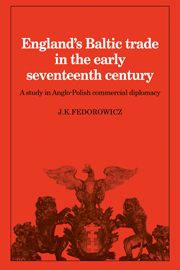 England's Baltic Trade in the Early Seventeenth Century
England's Baltic Trade in the Early Seventeenth Century Book contents
- Frontmatter
- Contents
- Preface
- List of maps and graphs
- List of abbreviations
- Map
- Introduction
- 1 English perceptions of the Polish Commonwealth
- 2 The mechanics of English diplomacy in the Eastland
- 3 The early history of the Eastland Staple at Elbing
- 4 The operation of the staple
- 5 The pattern of English shipping into the Baltic
- 6 English exports to the Baltic
- 7 English imports from the Baltic
- 8 The threat to the Eastland Staple at Elbing
- 9 The depression of 1620 and the crisis of England's Baltic trade
- 10 The political crisis, 1620–9
- 11 The mission of Sir Thomas Roe to the Eastland
- 12 Attempts at reconciliation with Danzig, 1630–5
- 13 The climax of English commercial diplomacy, 1635–42
- 14 Conclusion
- Notes
- Bibliography
- Index
3 - The early history of the Eastland Staple at Elbing
Published online by Cambridge University Press: 05 November 2011
- Frontmatter
- Contents
- Preface
- List of maps and graphs
- List of abbreviations
- Map
- Introduction
- 1 English perceptions of the Polish Commonwealth
- 2 The mechanics of English diplomacy in the Eastland
- 3 The early history of the Eastland Staple at Elbing
- 4 The operation of the staple
- 5 The pattern of English shipping into the Baltic
- 6 English exports to the Baltic
- 7 English imports from the Baltic
- 8 The threat to the Eastland Staple at Elbing
- 9 The depression of 1620 and the crisis of England's Baltic trade
- 10 The political crisis, 1620–9
- 11 The mission of Sir Thomas Roe to the Eastland
- 12 Attempts at reconciliation with Danzig, 1630–5
- 13 The climax of English commercial diplomacy, 1635–42
- 14 Conclusion
- Notes
- Bibliography
- Index
Summary
English relations with the southern shore of the Baltic can be traced back to the ninth-century voyage of Wulfstan to ‘Trusco’, identified by recent historians with the present-day Lake Drausen (Druzżno) near the town of Elbing (Elblag) in northern Poland. Commercial relations must have developed in the subsequent centuries as there is evidence of a regular English trade to the Baltic by the thirteenth century. By the year 1390, King Richard II granted a set of privileges to the merchants plying this trade though the extent to which this trade was organized or protected by the English government seems to have varied according to the external competition and threats it confronted.
There is literary evidence dating from the fifteenth century which suggests that England's Baltic links were already a significant element in the expansion of its commercial interests. The Libelle of Englyshe Polycye dating from 1436 mentions imports ‘fro Pruse’ (Prussia) of beer, bacon, copper, bowstaves, steel, wax, skins, pitch, tar, boards, flax, threads, linens and canvas, noting that ‘of olde tyme thus it wase’. In return, Prussian merchants took from England woollen cloths of all colours ‘by dyers crafted ful dyverse’, which clearly means finished cloths, not the unfinished white cloths normally exported to the Netherlands. Of even greater significance is the description of imports of Prussian plates of silver and ingots of gold, signifying that the value of finished English cloth exports to Prussia exceeded that of the raw materials imported in exchange: England enjoyed a positive trade balance with Prussia ‘which is increase ful grete unto thys lande’.
- Type
- Chapter
- Information
- England's Baltic Trade in the Early Seventeenth CenturyA Study in Anglo-Polish Commercial Diplomacy, pp. 34 - 49Publisher: Cambridge University PressPrint publication year: 1980


